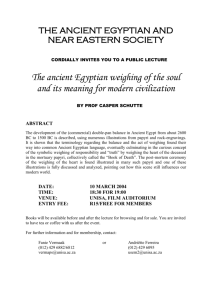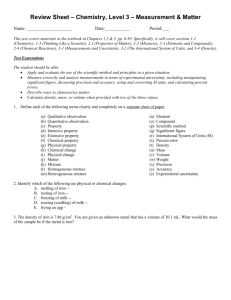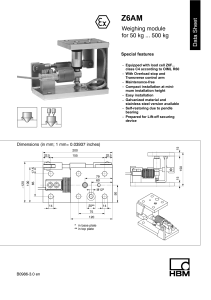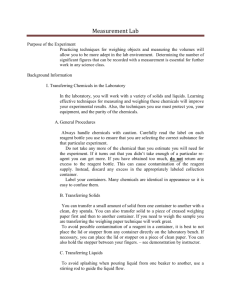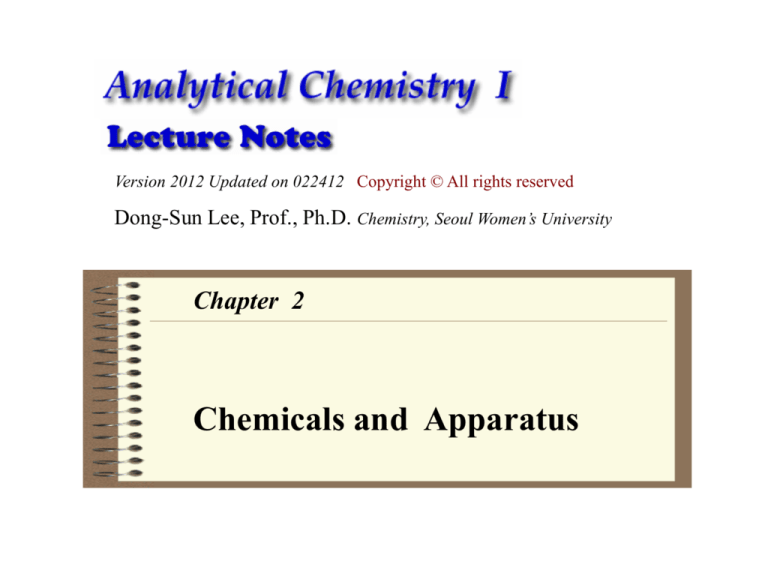
Version 2012 Updated on 022412 Copyright © All rights reserved
Dong-Sun Lee, Prof., Ph.D. Chemistry, Seoul Women’s University
Chapter 2
Chemicals and Apparatus
Classification of commercial chemicals
1) Technical or commercial grade
Not use in analytical work, but cleaning solution.
2) USP grade : United States Pharmacopoeia
The specifications are designed to limit impurities that are physiological
hazards
3) Reagent grade
Minimum specifications of the Reagent Chemical Committee of
the American Chemical Society
4) Primary standard grade / Reference standards
5) Special purpose reagents
Spectroscopic, chromatographic etc.
Primary standard
★★★
- Definition by the IUPAC(1978) :
a substance of high purity which, by stoichiometric reaction, is used to establish
the reacting strength of a titrant, or which itself can be used to prepare a titrant
solution of accurately known concentration.
- Requirements for a primary standard :
1) High purity (99.9% or better) 4) Ready availability
2) Stability in air
5) Reasonable solubility
3) Absence of hydrate water
6) Reasonable large formula weight
- Types of primary standards :
1) Reference material(RM) ; used mainly for the calibration
2) High purity substance = chemical standard
3) Certified reference material (CRM) ; by NIST, etc.
- Working or secondary standards
Inorganic
Reference materials
Organic
Nonferrous
Ferrous
Primary
standard
materials
Quality
of life
Certified reference
materials
Physical &
technical
properties
Biologicalclinical labs
Industry
RMs, CRMs, primary standard materials and their main application fields
Physical standards (kg)
International Prototype Kilogram: IPK:
Kilogram Standard: Le Gran K: 1 kg
Chemical
standards(12C,
Analytical standards
Reference
materials
N)
Primary
standards
Chemical standards
Secondary
standards
CRM
(pure substance)
Types of analytical standards, and relationships between them and traceability of
physical, chemical and analytical standards.
Table Selected pure chemical standards used in titrimetric analysis
(at least 99.9% purity) ★★★
Type of titration
Standard
Acid-base
Potassium hydrogen phthalate
Sulfanilic acid, Benzoic acid
Sodium carbonate, Borax
Complexometric
Calcium carbonate,
Magnesium,
Zinc,
EDTA
Precipitation
Silver, Silver nitrate, Sodium chloride
Redox
Potassium iodate, Potassium dichromate,
Sodium oxalate, Arsenic oxide
Rules for Handling Reagents and Solutions
1. Select the best grade of chemical / pick the smallest bottle
2. Replace the top of every container immediately after removal of the reagent
3. Hold the stoppers of reagent bottles between your fingers;
never set a stopper on a desk
4. Never return any excess reagent to a bottle.
5. Never insert spatulas, spoons, or knives into a bottle that contains a solid
chemical. Pour out the desired quantity.
6. Keep the reagent shelf and the lab balance clean and neat.
7. Observe local regulations concerning the disposal of surplus reagents and
solutions
Safe handling of chemicals and waste
- Material Safety Data Sheet (MSDS) : http://family.swu.ac.kr/~cat/links-1.html/
- Primary safety rule is not to do something that you consider to be dangerous.
- Goggles or safety glasses with side shields are necessary at all times in every
laboratory to protect you from flying liquids and glass.
- Food is never eaten in the lab.
- Organic solvents and conc. acids that produce harmful fumes should be handled only
in a fume hood. The purpose of a fume hood is to reduce levels of pollutants.
- Solid or liquid spills should be cleaned up immediately to prevent accidental contact
by the next person who comes along.
- Chemical spills on your skin usually are treated first with water. Rubber gloves are
recommended to protect your hands.
- Proper chemical storage minimizes fire and explosion hazards and human contact
with vapors.
- Preservation of a habitable environment on our planet demands that we minimize
waste production and responsibly dispose of the waste.
Goggle
All vessels should have labels that indicate what they contain.
Safety equipment and hazardous operations are prominently labeled.
(D.C. Harris, Quantitative Chemical Analysis, 4th ed., Freeman, 1995, p. 20)
Bumping is sudden, often violent boiling
that tends to spatter solution out of its
container.
Wet ashing is the oxidation of the organic
constituents of a sample with oxidizing
reagents such as nitric acid, sulfuric acid,
hydrogen peroxide, aqueous bromine, or a
combination of these reagents in a fumehood.
Arrangement for the
evaporation of a liquid
Analytical Balance
★★★
Readability:
An analytical balance measures masses
to within 0.0001 g. Use these balances
when you need this high degree of
precision.
Capacity: 100 ~ 220 g
Types of balances and principles of operation
Types of balance
Principles of operation
Mechanical balance
Equal-arm, double pan
Symmetric lever,
Triple beam dial
Pendulum
Dial
Unequal-arm, single pan
Substitution
Electronic balance
Top loading
Load-transfer mechanism,
Single pan analytical
electromagnetic force
Microbalance
compensation
Chemical Balance
Definition of terms
Mass : An invariant measure of the quantity of matter in an object.
Mass is constant.
Weight : The force of attraction exerted between an object and the earth.
Weight(w) equals mass(m) times the gravitational attraction (g=980.665 cm/s2).
w=gm
Balance : an instrument for weighing.
The word derived from the Latin bilanx =having two pans.
“scales” = old English, meaning dishes.
Capacity : the largest load on one pan for which the balance can be brought to
equilibrium
Sensitivity : the smallest increment of mass that can be measured
Readability ; Accurate, repeatable deflection at the smallest unit of measurement
Precision (standard deviation); Degree of agreement of repeated measurement of
the same object.
Accuracy ; The agreement between the result of measurement and the true value
of the quantity measured.
Resolution : number of scale division;
n = Max / d
Tare ; the mass of the empty vessel
Weights, Reference masses ;
The international prototype kilogram is a mass of platinum-iridium alloy made in
1887.
The International Bureau of Weights and Measures (Paris)
An ordinary set of analytical weights
100, 50, 30, 20, 10, 5, 3, 2, 1 g
500-100, 50-10, 5, 3, 2, 1 mg
Role of analytical balance : accuracy of analytical results depends on weight.
Table Classification of balances
Type
Reading to
Typical capacity(Max)
Ultramicroanalytical
0.1g
3g
Microanalytical
1g
3g
Semimicroanalytical
0.01mg
Macroanalytical
0.1 mg
100g~200g
Precision
1mg
160g~60kg
Rough weighing
0.01 g
350 g
0.1g
3500g
0.1g
6kg
30g
Weighing accurately = reading unit 0.1 mg
Vernier : A short auxillary scale placed along the main instrument scale to permit
accurate fractional reading of the least main division of the main scale, invented by
Pierre Vernier about 1630.
The vernier scale is graduated in one or both directions from the fiducial(index) mark
in numbered divisions, which are fractionally shorter than those on the main scale.
The position of the fiducial mark( the zero mark of the vernier scale) between
divisions on the main scale is indicated by the number of graduation on the vernier
scale which lines up exactly with a graduation on the main scale.
dm = l/n
dv = (l – dm) / n
Vernier caliper (G.S. Coyne, The Laboratory Handbook, Prentice Hall, 1992, p.68-69)
Coincidence
d
3
x
Index line
4
d’
Main scale
each division on the main scale is
1 mm
Vernier scale
each division on the Vernier scale is
0·9mm
0
10
7
x = d – d’ = 7 (1) mm – 7 (0.9) mm = 7 (1-0.9) mm = 0.7 mm
Reading : 3.17 cm = 31.7 mm
0.25 mm
Reading: 16.25 mm = 1.625 cm
locking screw
inside diameter jaws
main scale
depth probe
outside diameter jaws
slide piece with index scale
(Vernier scale)
Vernier scales of chemical balance
( reading weight =18.2505 g).
Vernier scales. Left, Direct (reading 3.6). Right,
retrograde (reading 12.7)
Source: McGraw-Hill Encyclopedia of Science
& Technology, Vol.19, p.198. 1987.
Vernier scales of dial balance
Certified analytical weights
Class M analytical weights are high precision standards used as reference standards for
analytical work.
Gram weights are normally made of brass and plated with gold, platinum or rhodium.
Class S weights are precise scientific working standards that are
chiefly used for calibration of other weights.
Class S-1 weights are routine analytical weights for general use.
Class P weights (formerly denoted by S-2 ) are rough weights.
Class J weights (up to 50mg) are used on microbalances.
Table
Tolerances of analytical weights provided by the NIST
Tolerance (mg)
Weight mass
Class M
Class S
Class S-1
10
Class P
1 kg
5.0
2.5
20
500g
2.5
1.2
5.0
100g
0.50
0.25
1.0
2.0
50g
0.25
0.12
0.60
1.2
10g
0.050
0.074
0.25
0.50
5g
0.034
0.054
0.18
0.36
1g
0.034
0.054
0.10
0.20
500mg
0.0054
0.025
0.080
0.16
100mg
0.0054
0.025
0.050
0.10
50mg
0.0054
0.014
0.042
0.085
20mg
0.0054
0.014
0.035
0.070
5mg
0.0054
0.014
0.028
0.055
2mg
0.0054
0.014
0.025
0.050
1mg
0.0054
0.014
0.025
0.050
10
All class J weights have a tolerance of 0.003mg
Cf. Standard specification for laboratory weights and precision standards
(1990 Annual Book of ASTM Standards)
Types
I & II
Grades
S, O, P, and Q
Classes
1, 2, 3, 4, 5, 6
Classification
표준 분동의 허용 오차: American Society of Testing & Measurement(ASTM E617)
(왼쪽) 백금(90%)-이리듐(10%) 합금으로 만들어진 국제 킬로그램 원기
(International Prototype Kilogram: IPK: Kilogram Standard: Le Gran K: 1 kg)
세브르(Sevres)에 위치한 국제도량형국(BIPM: Bureau International des Poids et
Mesures: International Bureau of Weights and Measures)에 보관
(오른쪽) 표준 분동
저울의 원리
1) Lever(지레) and pendulum(진자)
2) Newton’s 2nd law of motion (운동의 제 2 법칙)
3) Force moment(힘의 모멘트)
4) Hook’s law of elasticity (탄성력의 후크의 법칙)
4) Piezoeletric effect (압전기 효과)
5) Electromagnetic force compensator (전자기력 평형식)
W = F = 2rnBI
6) Load transfer mechanism (하중 전달 메커니즘):
압력 P를 힘 F로 변환
l1
l2
w1
w2
w1 = gm1
w2 = gm2
w1 l1 = w2 l2
if
l1 = l2
w1 = w2
m1 = m2
Principle of mechanical balance
Single-pan mechanical
analytical balance.
Sartorius 2842
balance
Single-pan mechanical balance. To weigh an object on the pan, we use the knobs on the
balance to detach removable weights until the balance beam is restored as near as
possible to its original position. Remaining small deflection is read on the optical scale.
P
Principles of electronic balance
1)
Alignment
marks
The load transfer mechanism
Pan surface area : A
Weighing load on the pan
backing
Transfer mechanism
Strain
sensitive
pattern
F = P dA
Pressure force (P)
Lever linkages ; elastic flexure pivots
Active
grid
length
Load cell
Translate
Solder
tabs
Electronic signal
Terminal (resistance legs)
Signal processing
and display
Measurable single force (F)
Strain gage load cell
2) The electromechanical transducer
Three part structure of
an electronic balance.
(= load cell)
Electromagnetic force compensator
Strain gage
(tension)
Maintain equilibrium
Weighing load
R1
Compensation force
W = P = F = l BI = n2rBI
B = magnetic flux density
I = current
3) The electronic signal processing part
R3
V
D
Where l = total length of coil wire
Strain gage
(tension)
A
B
R2
E = IR
Strain gage
(compression)
Rx
C
Strain gage
(compression)
An electronic balance (R.M. Schoonover, Anal. Chem. 1982, 54, 976A) and
top loading balance (K.M. Lang, American Lab., 1983, 15(3), 72)
Electronic balance. Displacement of the balance pan generate a correction current.
The electromagnet then restores the pan to its initial position. N and S are the north
and south poles of the permanent magnet.
Piezoelectric Effect
Crystals which acquire a charge when compressed, twisted or distorted are
said to be piezoelectric.
This provides a convenient transducer effect between electrical and mechanical
oscillations. Quartz demonstrates this property and is extremely stable. Quartz crystals
are used for watch crystals and for precise frequency reference crystals for radio
transmitters. Rochelle salt produces a comparatively large voltage upon compression and
was used in early crystal microphones. Barium titanate, lead zirconate, and lead titanate
are ceramic materials which exhibit piezoelectricity and are used in ultrasonic transducers
as well as microphones. If and electrical oscillation is applied to such ceramic wafers, they
will respond with mechanical vibrations which provide the ultrasonic sound source. The
standard piezoelectric material for medical imaging processes has been lead zirconate
titanate (PZT). Piezoelectric ceramic materials have found use in producing motions on the
order of nanometers in the control of scanning tunneling microscopes.
The word piezo is Greek for "push". The effect known as piezoelectricity was discovered
by brothers Pierre and Jacques Curie when they were 21 and 24 years old in 1880.
There is a magnetic analog where ferromagnetic material respond mechanically to
magnetic fields. This effect, called magnetostriction, is responsible for the familiar hum of
transformers and other AC devices containing iron cores.
http://hyperphysics.phy-astr.gsu.edu/hbase/solids/piezo.html
The diagram below provides an explanation of why the
piezoelectric effect exists. The diagram at the left depicts
six point charges (ions if you will), red being positive
charges and green negative. In a relaxed state with no
forces acting on them, they are arranged at the vertices of
an hexagon. If the electrical potential (V) at a point along
the x axes and distant from these charges one can see the
three positive charges will appear to act at the center of the
hexagon as will the three negative charges. The positive
and negative array of charges will cancel each other out
and the potential V, at a the distance along the x axes will
be zero.
If a compressive force is applied to the hexagon along the
Y axes direction, the array is distorted in such a way as to
bring two of the positive charges closer together at one end
and the negative charges at the other. This forms a dipole
where one end of the array is positive and the other
negative. A potential, V calculated at a distance along the
X axes will now be non-zero.
One can easily imagine a crystal structure made up of these
hexagonal arrangements of ions, all lined up in an orderly
matrix throughout the bulk of the crystal volume. When the
crystal is compressed, each hexagon would contribute to a
net polarization across the crystal.
http://www.tedlind.net/Piezoelectricity.htm
Electronic chemical
balance(left),
weights(center), top loading
balance(right) and
Rear weight is in the notch reading...… 70 g
Middle weight is in the notch................ 300 g
Front beam weight reads...................... 3.34 g
The object weighs
......................... 373.34 g
http://chemistry.rutgers.edu/genchem/balance3b.html
triple beam dial balance.
Using an Analytical Balance
Turn the balance on by pressing the control bar. The
display lights up for several seconds, then resets to
0.0000.
Place creased, small weighing paper on the balance pan.
Close the sliding glass doors. Wait for the green dot on
the left to go out. This is the stability indicator light,
indicating that the weight is stable.
http://www.dartmouth.edu/~chemlab/techniques/a_balance.html
Press the control bar to cancel out the weight of the
container or paper. The display will again read 0.0000.
Carefully add the substance to be weighed up to the
desired mass. Do not attempt to reach a particular mass
exactly.
Before recording the mass, close the glass doors and
wait until the stability detector lamp goes out. Record
mass of solid.
Don't pick up tare containers with bare hands since
your fingerprints add mass. Use Kimwipes or tongs to
prevent this.
Don't lean on the bench while weighing.
Do record the mass of your container, if you will need
it later.
Do check the level indicator bubble before weighing.
The two rear balance feet serve as leveling screws.
Clean-up
Use the brush provided to clean spills in the
weighing chamber. Discard any disposable tare
containers, weighing paper, or Kimwipes in the
nearest wastebasket.
Using a Top-loading Balance
Check if the balance is turned on. If
not, press the on/off button and wait
until the display reads 0.0 g.
Place a container or large, creased
weighing paper on the balance pan.
Push tare button to zero the balance.
Carefully add substance to the
container or paper. Record mass.
http://www.dartmouth.edu/~chemlab/techniques/top_balance.html
Clean-up
Use the brush provided
to clean any spills.
Discard any disposable
tare containers,
weighing paper, or
Kimwipes in the
nearest wastebasket.
Quantitative transfer of solid
sample.
Note the use of tongs to hold the
weighing bottle and a paper
strip to hold the cap to avoid
contact between glass and skin.
A, 종이로 말아서 칭량병(weighing bottle)
옮기기와
B, 칭량접시(weighing dish).
Errors in weighing mass :
1) Changes in moisture or CO2 content
2) Volatility of sample
3) Electrification
4) Temperature
5) Air buoyancy error :
This error is due to the weight of air displaced by the object
on the pan and is generally quite small.
There will be a buoyancy correction whenever the density of
the object is not equal to the density of the standard weights.
Buoyancy equation :
m = [m’{1 (da / dw)} / {1 (da / d )}]
where m = true mass, m’ = mass read from a balance,
da = density of air ( 0.0012 g/ml near 1atm and 25oC ),
dw = density of balance weights (typically 8.0 g/ml )
d = density of object being weighed
Weighing methods :
Weighing by directly
Weighing by difference hygroscopic reagents
Equipment and Manipulations Associated with Weighing
Weighing bottles
Desiccators and Desiccants
Manipulating weighing bottles
Weighing by difference
Weighing hygroscopic solids
Weighing liquids
Drying
Constant mass: In gravimetric analysis the product is heated and cooled to
room temperature in a desiccator until successive weighings are “constant”. It
is usually taken as about 0.3mg.
Drying oven: to dry (110~200oC) samples prior to weighing
Muffle furnace : to ignite(pyrolysis) samples to high temperature (500~1200oC)
Remember to keep the watch glass as a dust cover on and the weighing bottle
top off while drying in the oven or desiccator.
(a) Ordinary desiccator. (b) Vacuum desiccator that can be evacuated through
the sidearm at the top and then sealed by rotating the joint cintaining the
sidearm. Drying is more efficient at low pressure.
Allow the weighing bottle (top off) to equilibrate overnight in the desiccator.
The following period, place the top back on the weighing bottle and keep it
this way while storing in the desiccator.
Efficiencies of drying agents
Agents
Formula
Water left in atmosphere
(g H2O/L)
Alumina
Al2O3
2.9
Anhydrone
Mg(ClO4)2 1-1.5H2O
1.5
Ascarite
NaOH on asbestos
Barium oxide
BaO
Barium perchlorate
Ba(ClO4)2
Calcium chloride (dried at 127oC)
CaCl2
Calcium oxide
CaO
Calcium sulfate( Drierite )
CaSO4
67
Lithium perchlorate, anhydrous
LiClO4
13
Magnesium oxide
MgO
Magnesium perchlorate, anhydrous
Mg(ClO4)2
0.2
Phosphorous pentoxide
P4O10
3.6
Potassium hydroxide
KOH
939
Sodium hydroxide
NaOH
513
Sulfuric acid (98 %)
H2SO4
3
93
2.8
599
67
656
753
Intermission Break
Thanks.
To be continued (Chapter 2).

